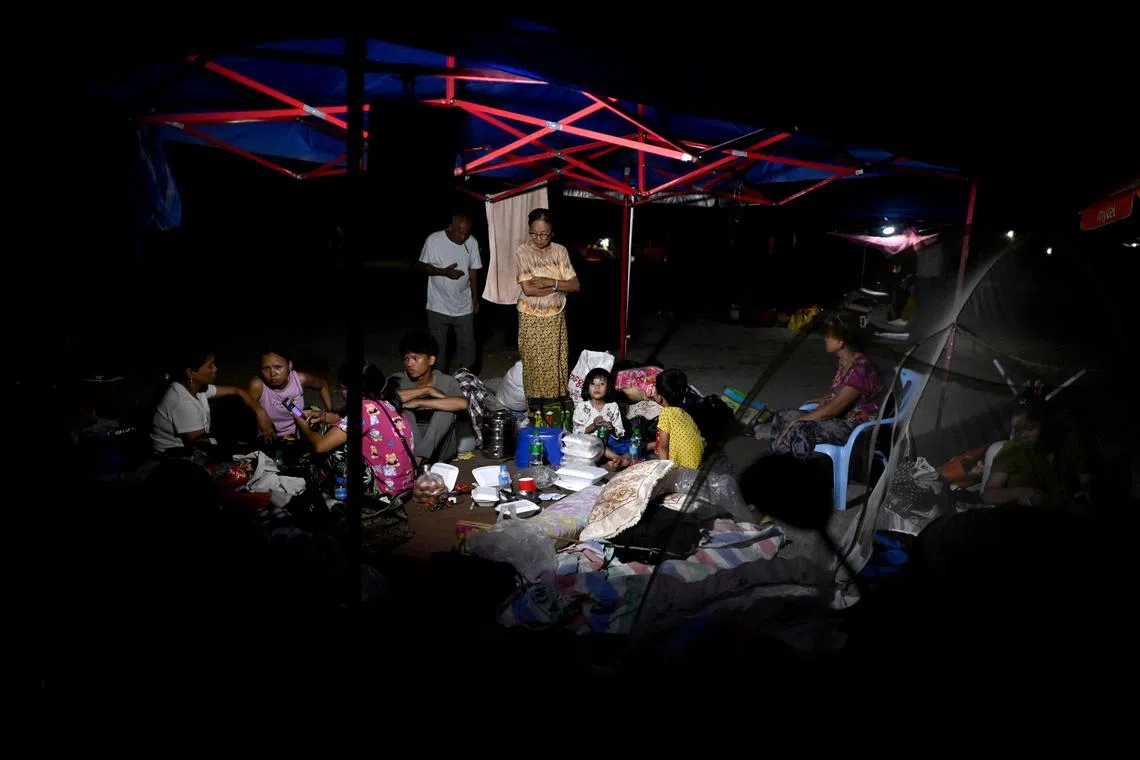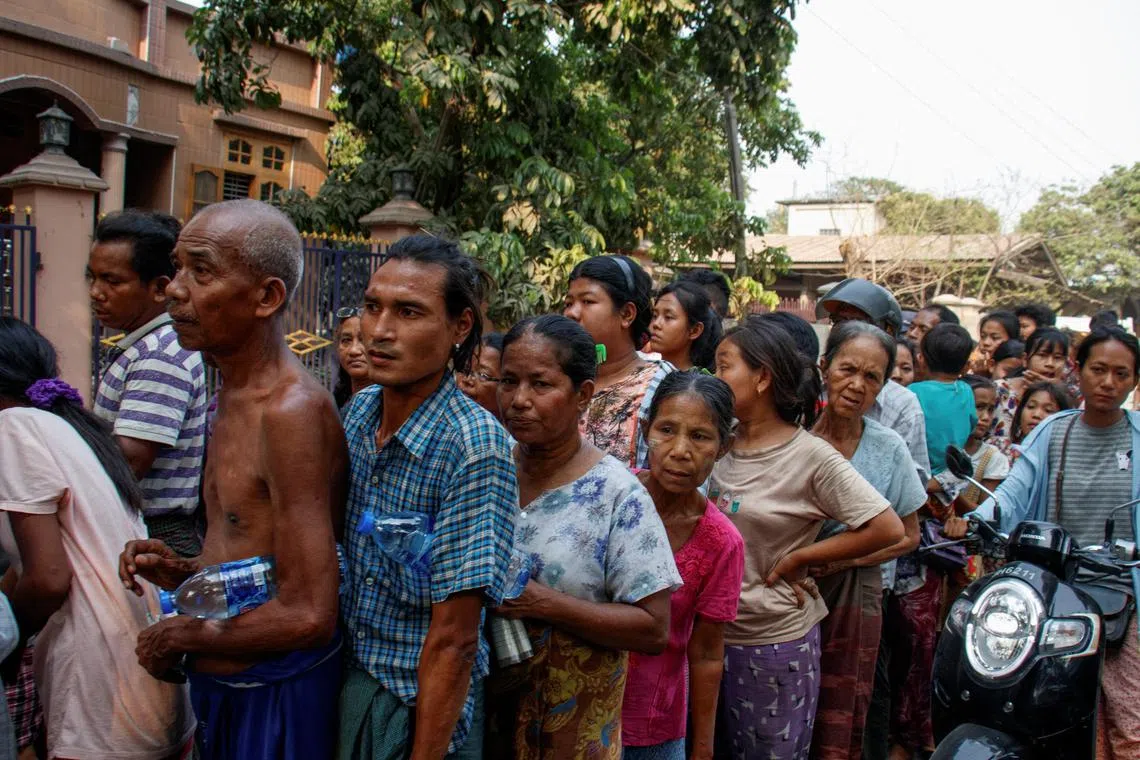Myanmar holds minute of silence for close to 3,000 quake dead
Sign up now: Get insights on Asia's fast-moving developments

People taking shelter in temporary tents set up outdoors in Mandalay, Myanmar, on March 31, following a deadly earthquake.
PHOTO: AFP
Follow topic:
MANDALAY – Myanmar held a minute of silence on April 1 in tribute to victims of a catastrophic earthquake
Four days after the 7.7-magnitude earthquake struck, many people in Myanmar are still sleeping outdoors, either unable to return to ruined homes or afraid of further aftershocks.
Sirens rang out at 12.51.02 (2.21pm Singapore time) – the precise time the quake struck on March 28 – bringing the country to a standstill to remember those lost.
Mandalay, Myanmar’s second-largest city and home to more than 1.7 million people, suffered some of the worst destruction, with many residential buildings collapsed into piles of rubble.
Outside the Sky Villa apartment complex, one of the city’s worst-hit disaster sites, rescue workers stopped and lined up with hands clasped behind their backs to pay their respects.
Officials and attendants stood behind a cordon, watching relatives further back, as the sirens wailed and a Myanmar flag flew at half-mast from a bamboo pole tied to a rescue tent.
The moment of remembrance is part of a week of national mourning
The junta said on April 1 that 2,719 have now been confirmed dead, with more than 4,500 people injured and 441 still missing. At least 20 people died in neighbouring Thailand.
The toll is expected to rise significantly as rescuers reach towns and villages where communications have been cut off by the quake.
In one miraculous development, a woman was rescued in the Myanmar capital of Naypyitaw on April 1, after being trapped by debris for 91 hours.
The woman, who is around 63 years old, was found alive on the morning of April 1, then “successfully rescued” and transferred to a hospital, the Myanmar Fire Services Department said in a Facebook post.
More than 1,000 foreign rescuers have flown in to help, and Myanmar state media reported that nearly 650 people have been pulled alive from ruined buildings around the country.
Sleeping in the open
Among the hundreds of residents who spent a fourth night sleeping in the open was Mr Soe Tint, a watchmaker.
“I don’t feel safe. There are six- or seven-floor buildings beside my house leaning, and they can collapse any time,” he told AFP.
Some residents have tents but many – including babies and children – have been bedding down on blankets in the middle of roads, staying as far away as possible from damaged buildings.
At an examination hall, where part of the building collapsed on hundreds of monks taking an exam, book bags were piled on a table outside, the uncollected belongings of the victims.
Fire engines and heavy-lifting vehicles were parked outside, and an Indian rescue team worked on the pancaked remains of the building.
The smell was “very high”, one Indian officer said. The stench of bodies rotting in the heat was unmistakable at several disaster sites around the city.
On the outskirts of Mandalay, a crematorium has received hundreds of bodies for disposal, with many more to come as victims are dug out of the rubble.
International aid effort
Even before the March 28 quake, Myanmar’s 50 million people were suffering, the country ravaged by four years of civil war sparked when the army ousted democracy icon Aung San Suu Kyi’s civilian government
The United Nations says at least 3.5 million people were displaced by the conflict before the quake, many of them at risk of hunger.
The junta says it is doing its best to respond to the disaster, but there have been multiple reports in recent days of the military carrying out air strikes on armed groups opposed to its rule, even as the country reels from the quake’s devastation.
UN special envoy to Myanmar Julie Bishop called for all parties to cease hostilities and focus on protecting civilians and delivering aid.
In response to the quake, junta chief Min Aung Hlaing issued an exceptionally rare appeal for foreign assistance, breaking with the isolated ruling generals’ customary practice of shunning help from abroad in the wake of major disasters.
International aid efforts since the quake have included an emergency appeal for US$100 million (S$134.2 million) to help victims from the International Federation of Red Cross and Red Crescent Societies.

People displaced by the March 28 earthquake queueing for relief supplies in Sagaing, Myanmar, on March 31.
PHOTO: REUTERS
Hundreds of kilometres away, the Bangkok city authorities said the death toll there had risen to 20, the vast majority killed when a 30-storey skyscraper under construction collapsed.
City Governor Chadchart Sittipunt told a news conference on April 1 that recovery efforts at the site of the collapse have entered a second phase that involves lifting all heavy materials, such as columns.
“We have hope there are survivors,” he said. “We will keep going.” AFP

